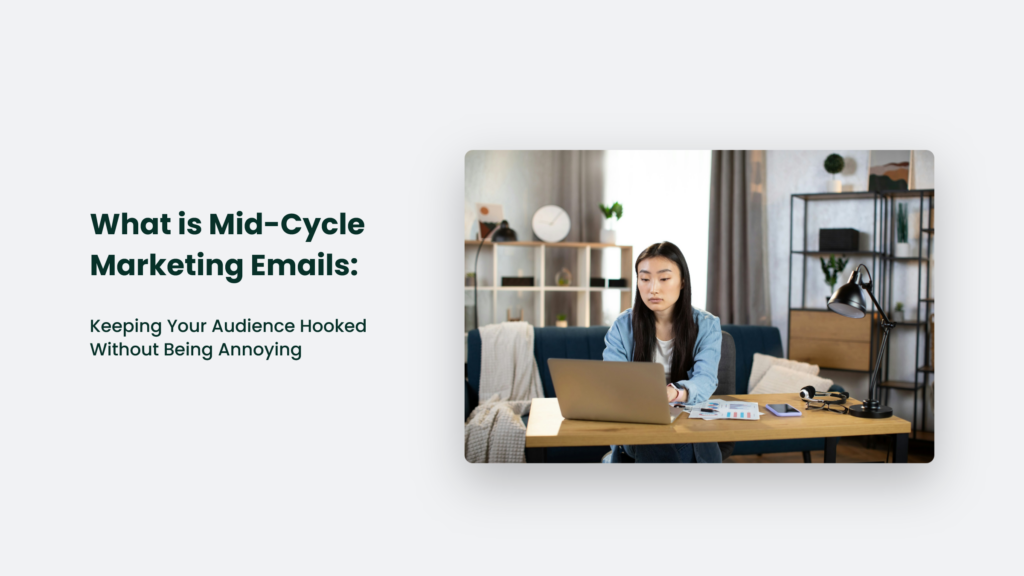Let’s face it: most marketing emails are as exciting as watching paint dry. But what if I told you there’s a secret weapon in the email marketing arsenal that can keep your audience engaged without making them want to hurl their devices out the window? Enter the mid-cycle marketing email.

What is a Mid-Cycle Marketing Email?
A mid-cycle marketing email is like that friend who knows exactly when to check in – not too often to be a pest, but just enough to remind you they exist. It’s a strategic communication sent between major campaigns or product launches, designed to keep your brand top-of-mind without shoving promotions down your audience’s throat. Think of it as the marketing equivalent of a “how you doin’?” text. It’s not trying to sell you anything (at least not overtly), but it’s keeping the conversation going.
The Magic Number: 2-4 Emails Per Month
According to research, 54% of brands send emails 2-4 times monthly. This frequency seems to hit the sweet spot for most audiences. It’s enough to maintain relevance without causing email fatigue. Here’s why this range works:
- Consistent Presence: Sending emails every few weeks ensures your brand stays on the radar.
- Avoiding Overwhelm: Subscribers rarely feel bombarded.
- Optimal Engagement: This frequency tends to yield higher open and click-through rates.
Why Mid-Cycle Emails Matter
Keeping You Relevant
In an age where attention spans are shrinking faster than a wool sweater in hot water, staying relevant is crucial. Mid-cycle emails serve as gentle reminders of your brand’s existence and value.
Nurturing Leads
These emails are the unsung heroes of the sales funnel. They guide prospects through decision-making without the pressure of a hard sell. You’re building trust and positioning your brand as a helpful resource by providing valuable content.
Boosting Engagement
Mid-cycle emails give your audience a reason to engage with your brand between major campaigns. These touchpoints keep the relationship warm, whether it’s educational content, industry insights, or exclusive offers.
Gathering Insights
Every mid-cycle email is an opportunity to learn more about your audience. You can gather valuable data to refine your overall marketing strategy by analyzing open rates, click-throughs, and responses.
The Numbers Don’t Lie
Let’s look at some statistics that underscore the importance of mid-cycle emails:
- Personalized mid-cycle emails have an 18.8% average open rate, compared to 13.1% for non-personalized emails.
- Segmented campaigns can lead to a whopping 760% increase in revenue.
- Adding a call-to-action button instead of a text link can increase click-throughs by 28%.
Crafting Mid-Cycle Emails That Don’t Suck
Know Your Audience (Like, Really Know Them)
Segmentation is your best friend here. Divide your audience based on their behaviour, preferences, or demographics. It’s like creating a mixtape for each of your friends instead of blasting the same playlist at everyone.
Timing is Everything
Don’t be that person who texts at 3 AM. Find the sweet spot for your audience. Most brands find success sending 2-4 emails per month.
Provide Value (Or Don’t Bother)
Your mid-cycle email should be like a gift – something your audience actually wants to receive. It could be:
- Educational content
- Exclusive offers
- Behind-the-scenes peeks
- Industry insights
Keep It Short and Sweet
Remember, your audience’s time is precious. Aim for 50-125 words – long enough to say something meaningful and short enough to keep their attention.
Personalize (But Don’t Be Creepy)
Use your subscriber’s name and reference their past interactions, but draw the line when mentioning that pizza they ordered at 2 AM last Saturday.
Examples That Actually Work
- The Educational Email: A software company sends a guide on optimizing their product. It’s helpful, not sales, and keeps the brand in mind.
- The Re-engagement Email: A fitness app sends a limited-time offer to users who last logged in. It’s a gentle nudge, not a desperate plea.
- The Feedback Request: An e-commerce site asks for product reviews. It shows they value customer opinions and provides social proof for future buyers.
The Balancing Act
Finding your ideal email frequency is an ongoing process. It requires continuous testing and refinement. Here’s how to strike the right balance:
- Monitor Engagement Metrics: Keep a close eye on open, click-through, and unsubscribe rates.
- A/B Testing: Experiment with different frequencies and content types to see what resonates best with your audience.
- Listen to Your Audience: Pay attention to direct and indirect feedback about your email frequency.
Conclusion: The Power of “Just Right”
When done right, mid-cycle emails are the Goldilocks of your marketing strategy – not too much, not too little, but just right. They keep your brand relevant, nurture leads, boost engagement, and provide valuable insights.
By finding your sweet spot between 2 and 4 emails per month and focusing on delivering value, you can create an email marketing strategy that’s just right for your audience. Remember, email marketing is not about bombarding your audience with messages.
It’s about sending the right message to the right person at the right time. And that, my friends, is what mid-cycle marketing emails are all about.
Frequently Asked Questions:
What content works best for mid-cycle emails?
The best content provides value to your audience. This could include educational articles, product tips, industry news, exclusive offers, or behind-the-scenes content. The key is to focus on nurturing the relationship rather than hard selling.
How do I measure the success of my mid-cycle email campaigns?
Key metrics to track include open, click-through, conversion, and unsubscribe rates. Also, pay attention to overall engagement trends and how these emails impact your broader marketing goals.




